Nestled between the lodgepole pines and blue spruce trees at the base of Breckenridge Ski Resort’s Peak 9 lies BOEC’s crown jewel, it’s 39-acre Wilderness Campus. Located at 9,938 feet in elevation the campus is equipped with the 6,000 square foot Griffith Lodge, an old miner’s cabin from the 1930s, an intern cabin, multiple accessible campsites, a climbing wall and an accessible fishing pier off the 10-acre Sawmill Reservoir, making it a summer haven for most of BOEC’s summer Wilderness Programs. But one aspect in particular makes this place so unique, and that comes in the form of the largest accessible high ropes course in the country.
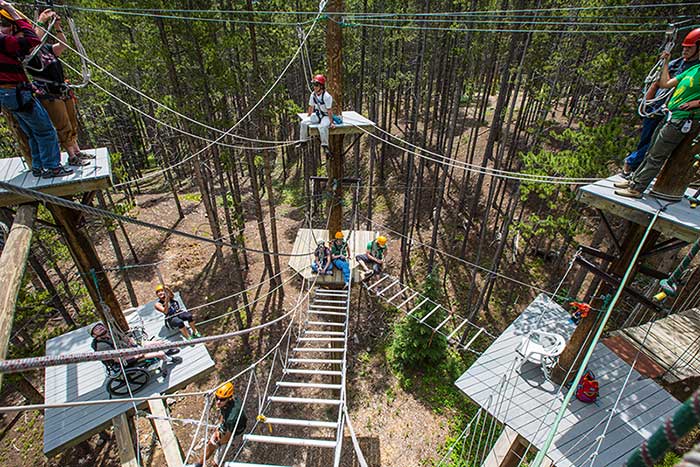 In 1982, BOEC began investing in high and low ropes courses on the Wilderness Site. The High Y and the Wave along with several Low V’s, spiderwebs, an acid river, trust falls, creek crossing, and a zig zag walk were added. These elements were not very accessible to many of our students so in 1986, a wheelchair accessible ropes course was added. This course includes two levels with 10 course elements, a rappel and a zipline.
In 1982, BOEC began investing in high and low ropes courses on the Wilderness Site. The High Y and the Wave along with several Low V’s, spiderwebs, an acid river, trust falls, creek crossing, and a zig zag walk were added. These elements were not very accessible to many of our students so in 1986, a wheelchair accessible ropes course was added. This course includes two levels with 10 course elements, a rappel and a zipline.
The first level is approximately 30 feet above the ground with the second level close to 50 feet. On the first level you have the Burma Bridge, uneven logs with ropes, uneven logs without ropes, the postman’s walk, the parallel ladder and the zip line. And on the second level the vertical ladder, the grapevine, the kitten crawl, the hourglass, the balance beam and rappel station. Within this unique design, each element is built to flow as a progression starting with very solid things to stand on with lots of hand holds progressing to sections with more perceived exposure. It’s meant to flow so everyone can move about and challenge themselves as much as they want, as well as be a part of the support team for everyone else.
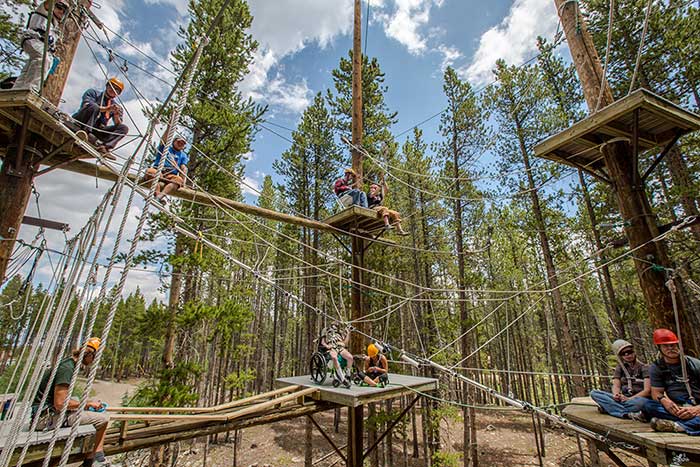 First of all, the course was built specifically with BOEC students in mind. It’s square design and intimate nature allow everyone to see and cheer each other on versus the typical challenge course that is usually long and linear where you cannot see one another as you progress. This design – with elements approximately 20 feet from each other – allows for camaraderie, support and teambuilding, which are all key parts of BOEC’s unique programs. Secondly, the BOEC ropes course is wheelchair accessible where one can actually roll out on the course and complete three of the 10 elements in their chair. As it’s built into a hillside which makes the bridge from solid ground possible, this part of the course is unlike any other course. Most
First of all, the course was built specifically with BOEC students in mind. It’s square design and intimate nature allow everyone to see and cheer each other on versus the typical challenge course that is usually long and linear where you cannot see one another as you progress. This design – with elements approximately 20 feet from each other – allows for camaraderie, support and teambuilding, which are all key parts of BOEC’s unique programs. Secondly, the BOEC ropes course is wheelchair accessible where one can actually roll out on the course and complete three of the 10 elements in their chair. As it’s built into a hillside which makes the bridge from solid ground possible, this part of the course is unlike any other course. Most 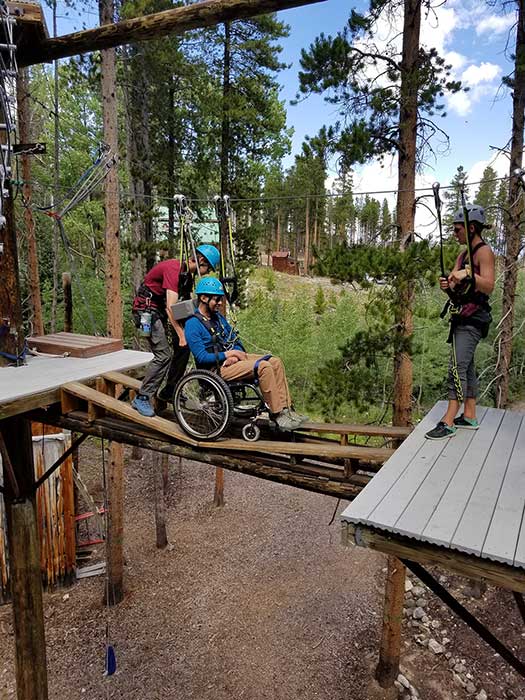 “accessible” challenge courses require someone to be hoisted from the ground or to climb a cargo net to access the course. Those three wheelchair accessible elements are not the only parts of the course that a participant in a wheelchair can enjoy. As a participant in a wheelchair can venture outside of their chair with the use of pulleys and ropes for them to be able to continue on and enjoy some of the other seven course elements. Thirdly, each of the platforms between the elements are large enough for wheelchairs – and even camp chairs – to hang out and watch and/or rest between tackling elements. Again, allowing for participants to support and encourage each other as part of the process.
“accessible” challenge courses require someone to be hoisted from the ground or to climb a cargo net to access the course. Those three wheelchair accessible elements are not the only parts of the course that a participant in a wheelchair can enjoy. As a participant in a wheelchair can venture outside of their chair with the use of pulleys and ropes for them to be able to continue on and enjoy some of the other seven course elements. Thirdly, each of the platforms between the elements are large enough for wheelchairs – and even camp chairs – to hang out and watch and/or rest between tackling elements. Again, allowing for participants to support and encourage each other as part of the process.
Recent Brain Injury Alliance of Colorado rope course participant Andrea Vellinga says, “It was amazing and fun and it helped me overcome my fears. I did so much more than I thought I could ever do.”
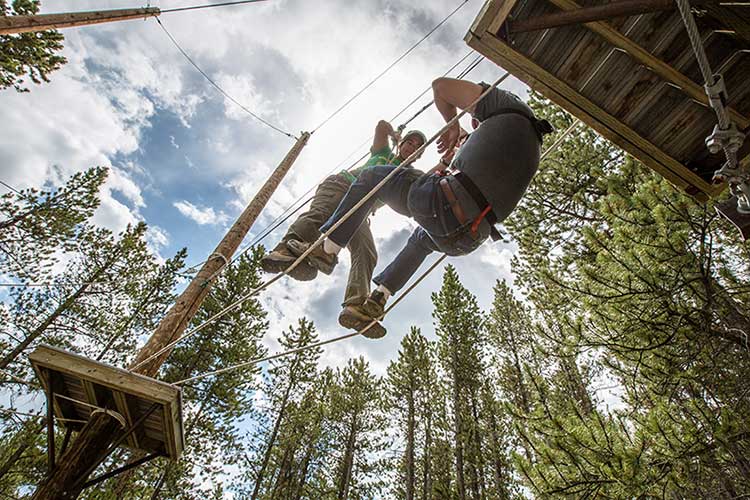 As mentioned, the BOEC ropes course has two levels with 10 elements plus the zipline and rappel. The first level is approximately 30 feet above the ground with the second level close to 50 feet. On the first level you have the Burma Bridge, uneven logs with ropes, uneven logs without ropes, the postman’s walk, the parallel ladder and the zip line. And on the second level the vertical ladder, the grapevine, the kitten crawl, the hourglass, the balance beam and rappel station. Within this unique design, each element is built to flow as a progression starting with very solid things to stand on with lots of hand holds progressing to sections with more perceived exposure. It’s meant to flow so everyone can move about and challenge themselves as much as they want, as well as be a part of the support team for everyone else.
As mentioned, the BOEC ropes course has two levels with 10 elements plus the zipline and rappel. The first level is approximately 30 feet above the ground with the second level close to 50 feet. On the first level you have the Burma Bridge, uneven logs with ropes, uneven logs without ropes, the postman’s walk, the parallel ladder and the zip line. And on the second level the vertical ladder, the grapevine, the kitten crawl, the hourglass, the balance beam and rappel station. Within this unique design, each element is built to flow as a progression starting with very solid things to stand on with lots of hand holds progressing to sections with more perceived exposure. It’s meant to flow so everyone can move about and challenge themselves as much as they want, as well as be a part of the support team for everyone else.
 Due to the inherent safety risks, the ropes course is inspected every day by the staff that use it. In addition, there is an annual in-house inspection as well as an outside vendor that comes annually to inspect each and every component of the course. Literally, every single nut and bolt gets torqued to a very specific amount, and every board, structural piece, rope, harness and carabiner gets inspected. And all of this follows the Association for Challenge Course Technology (ACCT) and Association for Experiential Education (AEE) guidelines and regulations for a strict set of standards that each and every piece of the ropes course and all staff training requirements must follow.
Due to the inherent safety risks, the ropes course is inspected every day by the staff that use it. In addition, there is an annual in-house inspection as well as an outside vendor that comes annually to inspect each and every component of the course. Literally, every single nut and bolt gets torqued to a very specific amount, and every board, structural piece, rope, harness and carabiner gets inspected. And all of this follows the Association for Challenge Course Technology (ACCT) and Association for Experiential Education (AEE) guidelines and regulations for a strict set of standards that each and every piece of the ropes course and all staff training requirements must follow.
“With safety and risk management being one of our highest priorities, the BOEC spends countless hours training our staff on our ropes courses to be sure they can mitigate as many risks as possible and facilitate successful experiences for all,” says Wilderness Program Director Jaime Overmyer. “With our rigorous attention to the aforementioned standards, as well as industry norms, we stay on the cutting edge of technology and methodologies”
 With all this being said, it’s the human element that makes the BOEC ropes course so special as each student that participates has a different experience based on their unique situation. BOEC guides programs offering a challenge by choice methodology in which participants are encouraged to go outside their comfort zone to experience new things but are never forced to do something they aren’t comfortable with. Ultimately, the idyllic natural setting and all of the bridges and elements of the course are meant to help build someone’s confidence in themselves. Overmyer explains, “One person’s
With all this being said, it’s the human element that makes the BOEC ropes course so special as each student that participates has a different experience based on their unique situation. BOEC guides programs offering a challenge by choice methodology in which participants are encouraged to go outside their comfort zone to experience new things but are never forced to do something they aren’t comfortable with. Ultimately, the idyllic natural setting and all of the bridges and elements of the course are meant to help build someone’s confidence in themselves. Overmyer explains, “One person’s  challenge may be simply to get the harness on, and that’s good enough for them,” she states. “We meet folks where they are. If that was all they wanted to do we support and celebrate that. Someone else might want to do all of the elements. Awesome! They can, and the rest of the team will help them do it through cheering and problem solving etc. It truly is a personal experience for each person that goes out.”
challenge may be simply to get the harness on, and that’s good enough for them,” she states. “We meet folks where they are. If that was all they wanted to do we support and celebrate that. Someone else might want to do all of the elements. Awesome! They can, and the rest of the team will help them do it through cheering and problem solving etc. It truly is a personal experience for each person that goes out.”
A truly personal experience indeed. As you can see, the BOEC high ropes course is unique and special on “so many levels.”

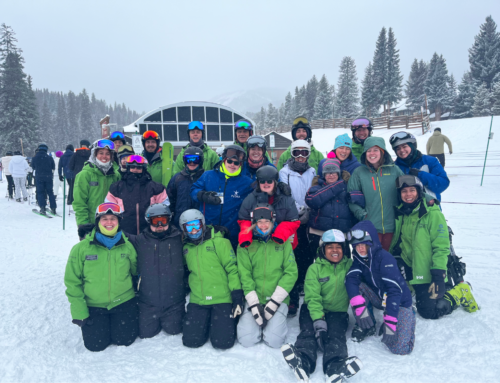
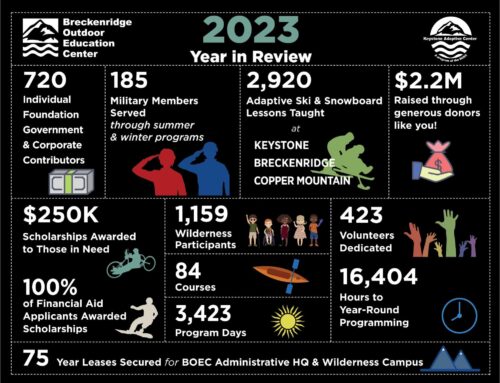


Leave A Comment